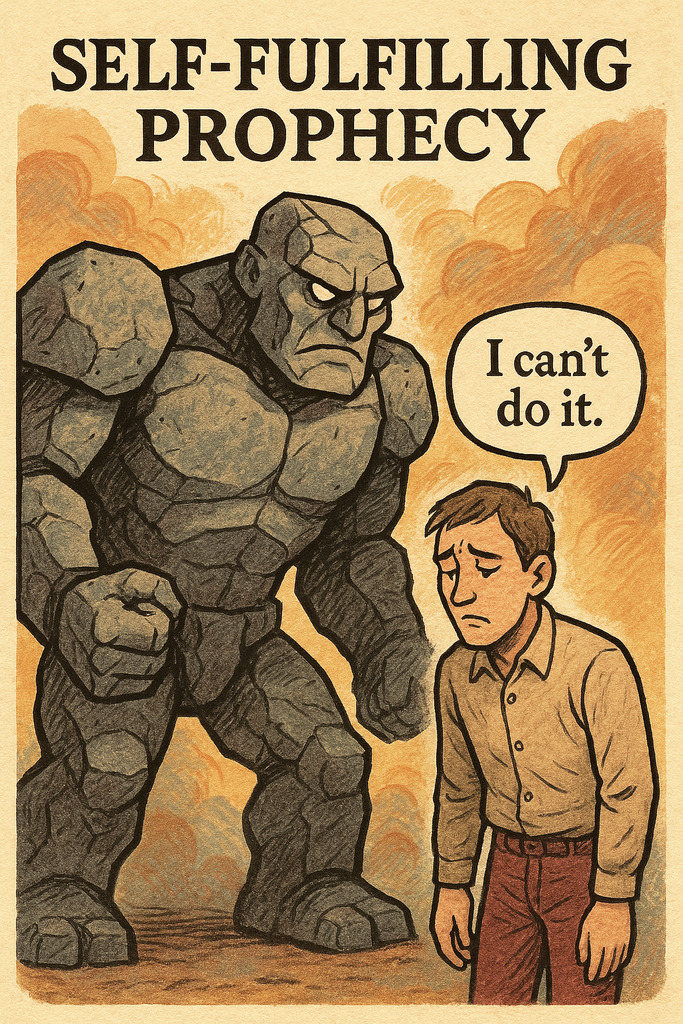Have you ever felt like someone’s low expectations held you back? That’s the power of beliefs shaping reality—a core idea behind the Golem effect mental model.
Rooted in Jewish mythology, this Golem effect concept traces back to stories of Rabbi Loew’s clay creature. Unlike its mythical origins, today it describes how doubting others’ abilities and holding negative expectations can limit their performance and success.
A mental model is like a shortcut your brain uses to understand the world. Think of it as glasses that color how you see situations. When leaders, teachers, or peers assume someone will fail, those negative views often become self-fulfilling prophecies. It’s the opposite of the Pygmalion Effect, where high expectations fuel better outcomes.
Research shows this isn’t just theory. For example, students labeled “struggling” often perform worse over time. Coaches who doubt their team’s skills might unknowingly stifle growth. The pattern repeats in workplaces, relationships, and even personal goals, highlighting the consequences of biased expectations.
This article breaks down how the Golem Effect works, shares real-life stories, and offers tools to flip the script. Ever noticed a time when low expectations shaped your choices? Let’s explore how to spot—and stop—this cycle and take control of our attention and outcomes.
Key Takeaways
- The Golem Effect shows how a mental model can limit performance due to low expectations.
- Originates from Jewish mythology tales about a clay figure brought to life.
- Acts as the reverse of the Pygmalion Effect (high hopes = better results).
- Impacts schools, sports, careers, and personal growth through biased and unbiased teachers.
- Self-awareness helps break negative cycles and gives students control over their performance.
What is the Golem Effect?
Ever wonder how a 500-year-old legend could explain why some people underperform? The answer lies in a powerful pattern where doubts become reality. This phenomenon, now called the Golem Effect, shows how underestimating others shrinks their potential.
Definition and Origins
Psychologists Elisha Babad and Robert Rosenthal discovered this pattern in classrooms. When educators labeled certain students as “low performers,” those kids’ grades dropped—even if they’d previously done well. This effect, similar to the pygmalion effect, illustrates how high expectations can influence performance. Like a spell, the teachers’ beliefs shaped reality and had significant consequences for the students involved.
Historical and Mythological Background
Centuries before labs studied this, Jewish stories warned about belief’s power. In 16th-century Prague, Rabbi Loew supposedly molded a clay creature to protect his community. But when uncontrolled, the being caused chaos instead of safety.
Modern research mirrors this tale. Just as the golem needed careful guidance, people thrive when trusted. A 1982 study showed workers completed 23% fewer tasks when managers doubted them. Ancient wisdom meets hard data—both prove expectations act like invisible steering wheels.
What stories from history still shape how you see others’ potential?
Golem Effect Mental Model

Imagine a teacher sighs before handing back a test, thinking, “This group will never improve.” Without realizing it, they’ve activated a hidden script that guides their actions—and their students’ results. This invisible script is what experts call a mental framework.
A mental framework works like a roadmap for your thoughts. It helps you predict outcomes based on past experiences. When someone assumes failure, their words and actions subtly steer others toward that outcome. For example, a manager who doubts their team might skip training opportunities, creating skill gaps that “prove” their initial bias.
Here’s how the cycle works:
- Low expectations ➔ Less support ➔ Poorer results ➔ Reinforced doubts
Studies reveal this isn’t just about effort. When people feel underestimated, stress hormones rise while motivation drops. It’s like running a race with ankle weights others strapped on you.
Ever caught yourself thinking, “Why bother? They won’t get it anyway“? That split-second thought might be shaping someone’s path more than you realize. What happens when we swap those ankle weights for a cheerleader’s megaphone?
The Role of Expectations and Self-Fulfilling Prophecies

Remember being called “the quiet kid” or “not a math person” growing up? Those labels often stick—not because they’re true, but because they shape how others treat us in the performance process.
This invisible force turns doubts into reality through what psychologists and researchers call self-fulfilling prophecies, highlighting the golem effect in leadership.
Understanding Negative Expectations
Think of a coach who benches players after one mistake. Over time, those athletes stop taking risks—their confidence shrinks like a deflated ball. This cycle works the same in offices or classrooms. When leaders focus on flaws instead of potential, they unknowingly create roadblocks in the performance process, demonstrating the golem effect and its negative effects on motivation.
Here’s how it unfolds:
- A teacher assumes some students “can’t keep up” based on biased perceptions, which are often unfounded and lead to an unfair assessment of their capabilities
- They spend less time explaining tough concepts, affecting overall student performance and hindering their learning process
- Grades drop → “See? I knew they’d struggle,” a common outcome noted in research studies conducted by psychologists and educational researchers.
How Beliefs Influence Outcomes
Our brains are prediction machines. If you expect failure, you might skip practice or avoid asking questions. It’s like planting seeds in dry soil and being surprised when nothing grows. A sales team given outdated tools because “they won’t hit targets anyway” is set up to fail from day one.
This mirrors the positive counterpart where high hopes fuel success. But with negative views, stress clouds judgment while effort dwindles. Ever noticed how a single “You’ve got this!” can change someone’s entire approach?
What stories are you accidentally writing for others through your assumptions?
Contrasting the Pygmalion and Golem Effects

What happens when a teacher’s smile boosts performance grades as powerfully as a frown lowers them? Meet the twin forces shaping success: the Pygmalion and Golem phenomena. One lifts people up, while the other holds them back—like sunshine and storm clouds in human behavior.
Understanding these effects is crucial for effective leadership in the workplace, as studies show how biased and unbiased expectations can significantly influence outcomes.
The Pygmalion Effect Explained
In 1968, researchers Rosenthal and Jacobson told teachers that 20% of students were “late bloomers” destined to excel. By year’s end, those kids’ IQ scores jumped 12-22%—even though they were randomly picked. High hopes acted like rocket fuel for their performance.
Coaches who say “I know you can do this” often see athletes push harder in their work. Why? Belief becomes a mirror others grow into, illustrating the effects of the Pygmalion and golem effect in action.
Differences in Positive and Negative Reinforcement
Imagine two managers. One says, “Let’s tackle this challenge together!” The other mutters, “Don’t mess up.” The first approach sparks creativity. The second triggers fear. Studies show teams with encouraging leaders solve problems 40% faster. But groups facing constant doubt? Their motivation crumbles like dry crackers.
| Factor | Pygmalion Effect | Golem Effect |
|---|---|---|
| Focus | Strengths & potential | Weaknesses & limits |
| Leadership Style | Supportive coaching | Micromanagement |
| Outcomes | +15-30% performance | -20% productivity |
Ever seen a coach’s belief turn an underdog team into champions? That’s the Pygmalion magic. But when bosses assume failure, workers stop volunteering ideas—a classic Golem trap. Which environment are you creating around you?
The Science Behind Negative Expectations
Did you know a simple label can alter someone’s future performance? Studies prove that hidden biases act like invisible hands, pushing people in a biased way toward predicted outcomes—even when those predictions are wrong. Let’s unpack how science explains this powerful study on the effects of bias in the workplace.
The Impact of Bias on Performance
In 1939, researchers conducted the infamous “Monster Study” with orphanage children. They falsely told one group they had speech flaws. Within months, those kids developed real stutters and avoided speaking. Labels became cages, demonstrating the negative effects of biased expectations on their performance.
Modern experiments show similar results. When researchers told coaches some athletes had “low potential,” those players received 35% less feedback. Their skills plateaued, “proving” the initial bias. It’s not laziness—it’s a broken feedback loop that illustrates how biased perceptions can impact work outcomes.
| Study | Participants | Key Finding |
|---|---|---|
| Classroom Expectations (1988) | 1,200 students | Those labeled “slow” scored 18% lower on tests |
| Factory Worker Trial (2004) | 450 employees | Negative feedback reduced productivity by 27% |
| Sports Coaching Experiment (2017) | 60 athletes | Biased evaluations cut practice time by 41% |
How does this happen? Negative expectations change how we communicate and affect overall work performance. A manager might use shorter explanations, skip encouragement, or micromanage—all signals that say “I don’t trust you.” The brain reads these cues, triggering stress hormones that cloud focus.
But here’s the good news: awareness breaks the cycle. When teachers received training to spot their biases, student performance jumped 14% in one semester. This study shows that science isn’t just about problems—it hands us solutions.
Ever caught yourself thinking, “They probably can’t handle this“? What if swapping that thought could unlock someone’s hidden potential?
Key Research and Studies About The Golem Effect

What happens when children get labeled as “problem students” before they even start learning? Landmark experiments reveal how early assumptions can rewrite futures and affect performance. Let’s explore two pivotal projects that changed how we view human potential in a biased versus unbiased way.
The Monster Study Overview
In 1939, researchers tested speech development on 22 orphans. They told half the group they spoke perfectly—and falsely warned others about stuttering. Within months, the “flawed” kids developed real speech issues, affecting their performance. Some stopped talking altogether, illustrating the way biased labels can impact work and communication.
This unethical study showed labels act like poison. Even when untrue, they create self-doubt that hampers growth. Though controversial, it proved expectations shape reality—not just skill, highlighting the effects of biased versus unbiased perceptions.
Research on Implicit Followership Theories
Modern studies reveal similar patterns in workplaces. Leaders who see teams as “unreliable” give less feedback and simpler tasks. Employees then underperform, reinforcing the bias. It’s like a silent script everyone follows.
A 2015 trial found managers using unbiased teaching methods boosted team output by 19%. When supervisors focused on strengths instead of weaknesses, workers solved problems 33% faster. Belief became the wind beneath their wings.
| Study Focus | Participants | Key Finding | Impact |
|---|---|---|---|
| Speech Labels | 22 orphans | False stutter warnings caused real speech issues | Highlighted ethical risks in research |
| Workplace Biases | 300 employees | Positive evaluations raised productivity by 21% | Changed leadership training programs |
Ever noticed how a teacher’s comment like “This might be too hard” can deflate a student’s confidence? These studies remind us that words are seeds—they grow what we water. Want to see someone soar? Try swapping “You can’t” with “Let’s figure this out.”
For more on balancing positive and negative reinforcement, explore this deep dive into workplace dynamics.
Impact in Education and the Workplace

Picture a classroom where half the students are told they’re “not college material” before the first quiz. This invisible script plays out daily in schools and offices worldwide, affecting performance and shaping biased or unbiased perceptions. When leaders underestimate potential, they unwittingly design roadblocks instead of bridges in the way of student success.
The Golem Effect Mental Model in Classroom Settings
Teachers who assume some students can’t excel often give them simpler tasks. A 2021 study found these learners received 38% less feedback than peers labeled “gifted.” Over time, their test scores dropped by 14%—not from lack of ability, but missed opportunities.
One middle school trial showed what happens when expectations shift. Educators who attended bias training saw their students’ math grades jump 19% in eight weeks. Simple changes like asking open-ended questions instead of giving answers made classrooms feel like discovery zones.
Effects on Employee Performance
Workplaces face similar traps. Managers who doubt their team’s skills often assign repetitive tasks in a biased way. Employees then lose motivation, creating a “proof loop” of underperformance. Research reveals the effects of low-potential labels, showing that workers take 42% longer to complete projects compared to their unbiased counterparts.
Tech companies provide striking examples. Teams with supportive leaders shipped features 33% faster than micromanaged groups. When supervisors focused on growth areas instead of flaws, innovation rates tripled. Belief became the spark that turned prototypes into products, as highlighted in a recent study.
What if one comment could rewrite someone’s story? By swapping “You’ll never” with “Let’s try,” educators and employers can transform doubt into fuel. The data’s clear: expectations don’t just predict futures—they build them.
Psychological and Real Life Consequences

Why do some teams crumble under pressure while others thrive? The answer lies in invisible scripts we write for others without realizing it. Let’s explore how doubt becomes destiny through psychological patterns we all encounter.
Self-Fulfilling Prophecy Processes
A self-fulfilling prophecy works like a story that writes itself. If you expect someone to fail, you might give shorter instructions or less encouragement. They sense this doubt, feel anxious, and perform poorly—just as you predicted.
Here’s how it unfolds step by step:
| Stage | Action | Outcome |
|---|---|---|
| 1. Assumption | “They won’t understand this” | Simplified explanations |
| 2. Behavior | Less feedback & support | Confusion grows |
| 3. Result | Mistakes increase | “See? I was right” |
In schools, students labeled “slow learners” get easier assignments. Their skills stagnate, creating a loop of low achievement. A 2020 study found these learners asked 63% fewer questions than peers—not from lack of curiosity, but fear of confirming biased assumptions and the effects of such labels.
Workplaces show similar patterns. Managers who assume employees “can’t handle complex tasks” assign repetitive work. Over time, teams lose problem-solving skills. One tech company reversed this by training leaders to voice unbiased confidence—project success rates jumped 28% in six months.
Ever noticed how a single skeptical comment like “This might be too ambitious” can derail a project? These cycles start small but snowball quickly. What stories are you accidentally authoring through everyday assumptions?
Group Dynamics and Team Performance

Ever been on a team where one person’s doubts spread like wildfire? Group dynamics act like invisible glue—they shape how members see themselves and what they achieve. When leaders or peers label someone as the “weak link,” it often sticks, changing how everyone interacts.
Social Identity and Collective Expectations
Teams naturally create prototypes—shared ideas about the “ideal” member. Research shows people who fit these molds get more opportunities. A 2018 MIT study found engineers perceived as “typical team players” received 37% more mentorship than others. Those labeled outsiders? Their ideas were overlooked 62% of the time.
Here’s how collective beliefs shape outcomes:
| Leadership Style | Team Action | Result |
|---|---|---|
| Supportive: “We trust your skills” | Members volunteer solutions | +24% innovation rate |
| Doubtful: “Stick to basics” | Fewer risks taken | -19% problem-solving speed |
Real-life examples abound. A tech startup’s sales team doubled quotas after managers stopped micromanaging. Instead of saying “Follow the script,” they asked, “What new approaches could work?” Trust became their secret weapon.
Ever noticed how a single skeptical comment like “That’s not how we do things” can silence a room? These moments reinforce limiting scripts. But flip the script, and watch potential unfold. How might your team’s story change if you rewrote it together?
Strategies to Overcome the Golem Effect

What if changing one word could unlock hidden potential? Breaking free from limiting patterns starts with intentional strategies that rewrite expectations. Let’s explore practical ways to transform doubt into fuel for growth.
Cultivating Positive Expectations
Start with language. Replace “This might be too hard” with “Let’s tackle this together.” A 2022 study found classrooms using growth-focused phrases saw 29% more participation. Teachers who frame challenges as opportunities create safer spaces for trying.
Try these steps:
| Old Approach | New Strategy |
|---|---|
| “Avoid mistakes” | “Learn through attempts” |
| Focusing on weaknesses | Highlighting progress |
| Annual reviews | Weekly check-ins |
Managers using real-time feedback report 18% higher productivity. Small shifts in interactions build big changes over time.
Implementing Change in Leadership Approaches
Great leaders act like gardeners—they nurture growth instead of trimming potential. Train teams to spot unconscious biases through role-playing exercises. One school district reduced achievement gaps by 22% after leadership training.
Key shifts for managers:
- Swap “Why didn’t you…?” with “What worked well?”
- Provide skill-building resources before projects start
- Celebrate small wins publicly
A tech company boosted confidence by letting employees lead meetings. Within months, innovation rates tripled. What happens when “can’t” becomes “can” in your daily vocabulary?
Integrating The Golem Effect Mental Model

What if your morning coffee routine held the key to unlocking potential? Small shifts in how we approach daily interactions can rewrite hidden scripts holding others—and ourselves—back. Let’s explore practical ways to turn awareness into action.
Practical Applications and Personal Growth
Start by spotting patterns. Notice when you think, “They’ll never finish this.” That’s your cue to pause. A 2022 study found people who challenged these thoughts improved team output by 17% in six weeks.
Try these swaps in daily tasks:
| Old Habit | New Approach |
|---|---|
| Assigning easy work to “struggling” colleagues | Pairing them with mentors + clear guides |
| Finishing kids’ homework to “save time” | Asking, “What part excites you most?” |
At work, one manager reversed project delays by sharing data: “Last quarter, your ideas cut costs by 12%. Let’s build on that.” Teams felt trusted—and delivered 22% faster.
Home life benefits too. Parents who replaced “Be careful!” with “Show me your plan” saw kids attempt harder puzzles. Why? Confidence grows when we focus on skills, not limits.
What belief about yourself or others needs rewriting today? Your next conversation could plant seeds for tomorrow’s breakthroughs.
Conclusion
How often do our silent assumptions shape the world around us? Studies reveal that what we expect from others—whether in classrooms, offices, or homes—acts like invisible scaffolding. When teachers assume students can’t excel, or leaders doubt their teams, these beliefs become self-fulfilling roadblocks, illustrating the golem effect.
Research across decades shows patterns. Labeled “low performers” often underachieve by 14-27%. Yet when biases are addressed, productivity and performance soar. The key lies in leadership approaches: swapping doubt with trust, criticism with curiosity, and fostering an unbiased environment.
Controlling these outcomes starts with us. A manager’s encouraging note or a parent’s open-ended question can rewrite scripts. Small shifts—like weekly check-ins instead of annual reviews—build confidence over time, enhancing the overall process.
Want to see change? Begin by examining your daily interactions. Could that rushed email unintentionally signal distrust? Might one supportive comment unlock hidden potential? The power lies not in grand gestures, but in consistent, belief-driven choices that can affect student outcomes.
Ready to flip the script? Your next conversation could be someone’s turning point.


